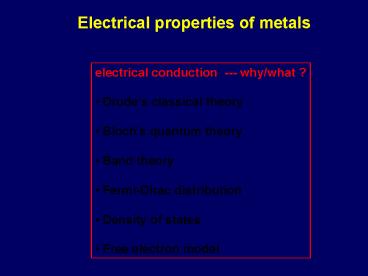Electrical properties of metals - PowerPoint PPT Presentation
1 / 28
Title:
Electrical properties of metals
Description:
giving good values for the vonductivity. Limitations of the classical model: ... Equipartition of energy: for each atomic degree of freedom ... – PowerPoint PPT presentation
Number of Views:374
Avg rating:3.0/5.0
Title: Electrical properties of metals
1
Electrical properties of metals
- electrical conduction --- why/what ?
- Drudes classical theory
- Blochs quantum theory
- Band theory
- Fermi-Dirac distribution
- Density of states
- Free electron model
2
Electrical conduction
tilting the energy bands
driving free electrons to move
Valence electron free electrons?
3
Drudes classical theory
kinetic molecular theory
mean free path
relaxation time (for l1nm t 10-14s)
under an applied electric field
E
Drift velocity
mobility
microscopic interpretation of Ohms law
current density
s (conductivity)
4
Success of Drudes theory
- being consistent with Ohms law
- qaulitatively explaining electrical resistence
penomenon - giving good values for the vonductivity
5
Limitations of the classical model
constant for close-packed structures with ions
of almost the same size
6
Limitations of the classical model
Alloying effect?
Temperature effect?
T -independent
Exp. Facts over a wide range of T
!
7
Limitations of the classical model specific heat
Equipartition of energy for each
atomic degree of freedom
In a solid
for each valence electron (3 x translational)
for each vibrating ion ( 3 x kinetic 3 x
potential)
Internal energy of a monovalent metal
Molar specific heat of a monovalent metal
For a divalent metal
For a trivalent metal
Experimental results
regardless of the valencey
8
Limitations of the classical model is electron
particle or wave?
Scattering (deflection)
Collision with ions in Drudes model
considering a large of ions in the crystal
By solving QM-equations for an electron in a
perfect crystal lattice Bloch (1925) e- (wave)
can pass perfect crystal without being scattered
Blochs model is correct. How comes the
resistance? non-perfect crystals
9
Blochs quantum theory of electrical conduction
processes limiting l
(i) Scattering by lattice thermal vibrations
(phonons!)
(ii) Scattering by impurities
- Drudes model vs. Blochs model
- very different interaction picture
- (collision vs. scattering)
- similar electron trajectories !
- same relavant parameters may have
- very different values
- (mean free path, drift velocity, mobility
- )
(iii) Scattering by lattice imperfections
10
Conduction electrons behaves as waves in a solid.
What energies can they have?
11
Electronic configurations from an atom to a
diatomic molecule
Molecular orbital diagram is valid for combining
similar atoms
Dihydrogen
anti-bonding (superposition out of phase)
bonding (superposition in phase)
Diboron(paramagnetic)
Dihelium
Dilithium
2p
2p
2s
2s
Hunds rule
1s
1s
2s
2s
1s
1s
1s
1s
12
(No Transcript)
13
Electronic configurations from an atom to an
aggregate
splitting of energy levels di-sodium
isolated Na-atom
aggregate of N Na-atoms
weaker interactions, narrower energy span
separation
14
Energy Bands electronic configurations of a solid
Energy levels in an aggregate of N atoms
Energy band in a macroscopic solid
N 1024 DE 0
DE eV/N
eV
?
15
Example Formation of energy bands in solid sodium
partially filled conduction band
completely filled, tightly bound to parent nucleus
How are the electrons distributed within the
allowed energy bands?
16
Electronic system in thermal equilibrium
Fermi-Dirac distribution
state occupation probability P(E) (Pauli
exclusion principle)
T0
Tgt0
Fermi energy
EF/kB gtgt RT!
density of states g(E) ( free electron model)
only in metals!
electronic density f(E)?g(E)
thermally activated
17
T0 (ground state)
Fermi-Dirac Distribution
thermally activated e-
Tgt0
k- (energy) space picture!
18
Density of states counting the of allowed
quatum states
histogram smooth curve
g(E) for typical metals
(majority in band middle)
lower bound of the energy band
upper bound of the energy band
19
The free electron model
Work function of metals f several eV
f gtgt ltEthgt
ltThermal energy of electronsgtRT ltEthgt kBT
0.025 eV
Approx. metal a box confining electrons with
infinite depth
Within a 1-dim. box
Eigenfunctions
nx positive integer
B.C.(2)
B.C.(1)
20
The free electron model counting the eigenstates
metal a box confining electrons with infinite
depth
3-dim. case
B.C.
at x0, y0, z0, xL, yL, zL
nx , ny, nz positive integer
Fermi surface
nmax
each grid point (nx , ny, nz) accomodates 2
e- ground state (2 e-) (nx , ny, nz)
(1,1,1) next (6 e-) (nx , ny, nz) (2,1,1),
(1,2,1), (1,1,2)
21
The free electron model counting the eigenstates
Fermi surface a surface in k-space !
nmax
Fermi energy (EF ) energy of the highest
occupied state ( T 0
K)
( of grid points beneath the Fermi surface)x2
total of valence electrons N
22
The free electron model Density of states
(free electrons)
typical metal
23
Counting the allowed states (Debye Model)
For a 1-dim. oscillator
stationary states
Volume per allowed state in k-space
For a 3-dim. oscillator
Volume per allowed state in k-space
24
Density of states D(w) vibrational modes
Singular points ?
state distribution is uniform in the k-space
25
The free electron model Density of occupied
states
Fermi-Dirac Distribution
Density of states of free electrons
active for conduction
26
Electrical conduction Band theory vs. Drudes
model
Estimating the value of ( of conduction el. /
of valence el.)
(1)
(2)
(Q4.17)
27
Electrical conduction Band theory vs. Drudes
model
electrons velocity (velocity at EF ) /
(thermal velocity at RT) 10
independent of T
0 as T 0 K
mean free path
l 1 nm
l depends on defects
l 1 mm for typical metals at RT
28
of valence el.































